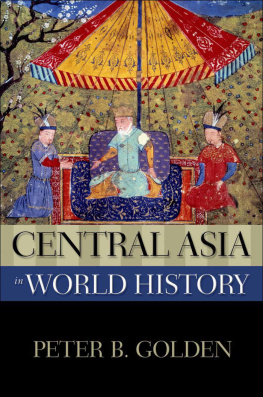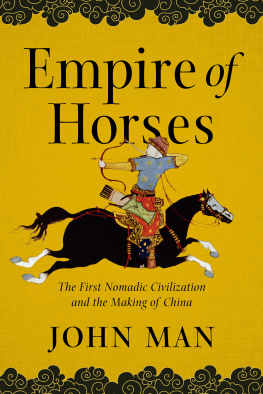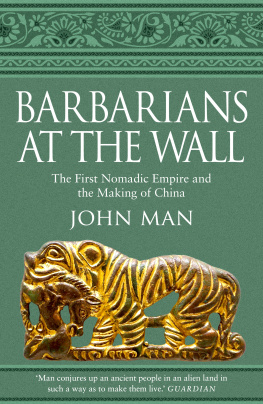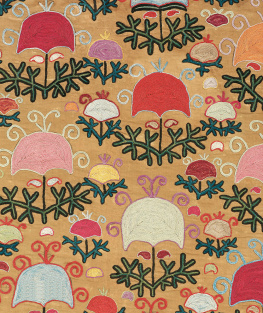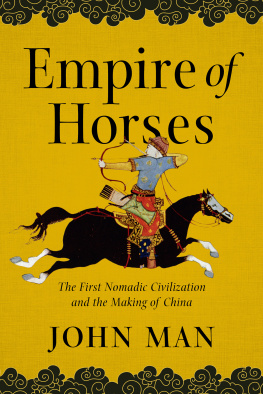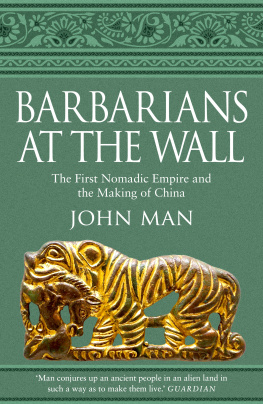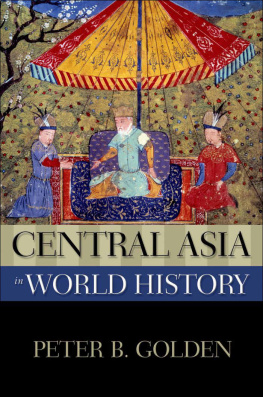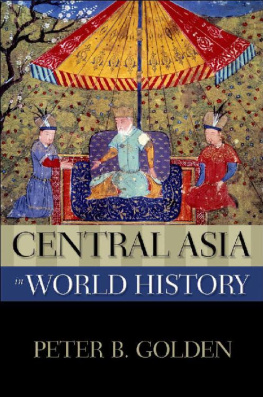Central Asia in
World History
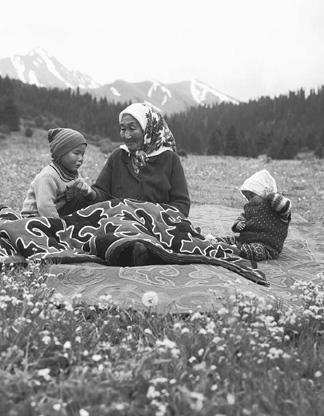

Central Asia in
World History
Peter B. Golden


Oxford University Press, Inc., publishes works that further
Oxford Universitys objective of excellence
in research, scholarship, and education.
Oxford New York
Auckland Cape Town Dar es Salaam Hong Kong Karachi
Kuala Lumpur Madrid Melbourne Mexico City Nairobi
New Delhi Shanghai Taipei Toronto
With offices in
Argentina Austria Brazil Chile Czech Republic France Greece
Guatemala Hungary Italy Japan Poland Portugal Singapore
South Korea Switzerland Thailand Turkey Ukraine Vietnam
Copyright 2011 by Oxford University Press, Inc.
Published by Oxford University Press, Inc.
198 Madison Avenue, New York, New York 10016
www.oup.com
Oxford is a registered trademark of Oxford University Press
All rights reserved. No part of this publication may be reproduced,
stored in a retrieval system, or transmitted, in any form or by any means,
electronic, mechanical, photocopying, recording, or otherwise,
without the prior permission of Oxford University Press.
Library of Congress Cataloging-in-Publication Data
Golden, Peter B.
Central Asia in world history / Peter B. Golden.
p. cm.
Summary: This work traces the history of the nomadic steppe tribes and sedentary
inhabitants of the oasis city-states of Central Asia from pre-history to the present.
Particular focus is placed on the unique melting pot cultures that this region has
produced over millenniaProvided by publisher.
ISBN 978-0-19-533819-5 (pbk.)ISBN 978-0-19-515947-9 (hardcover: alk. paper)
1. Asia, CentralHistory. 2. Asia, CentralCivilization.
3. Asia, CentralStrategic aspects. 4. GeopoliticsAsia, CentralHistory.
I. Title.
DS329.4.G598 2011
958dc22 2010020626
1 3 5 7 9 8 6 4 2
Printed in the United States of America
on acid-free paper
Frontispiece: A Kyrgyz grandmother with her grandchildren.
The Kyrgyz, like other Central Asian nomads, have a rich
history of rug making and embroidery.
ITAR-TASS
For Sylvia
Contents
Editors Preface
This book is part of the New Oxford World History, an innovative series that offers readers an informed, lively, and up-to-date history of the world and its people that represents a significant change from the old world history. Only a few years ago, world history generally amounted to a history of the WestEurope and the United Stateswith small amounts of information from the rest of the world. Some versions of the old world history drew attention to every part of the world except Europe and the United States. Readers of that kind of world history could get the impression that somehow the rest of the world was made up of exotic people who had strange customs and spoke difficult languages. Still another kind of old world history presented the story of areas or peoples of the world by focusing primarily on the achievements of great civilizations. One learned of great buildings, influential world religions, and mighty rulers but little of ordinary people or more general economic and social patterns. Interactions among the worlds peoples were often told from only one perspective.
This series tells world history differently. First, it is comprehensive, covering all countries and regions of the world and investigating the total human experienceeven those of so-called peoples without histories living far from the great civilizations. New world historians thus share in common an interest in all of human history, even going back millions of years before there were written human records. A few new world histories even extend their focus to the entire universe, a big history perspective that dramatically shifts the beginning of the story back to the big bang. Some see the new global framework of world history today as viewing the world from the vantage point of the Moon, as one scholar put it. We agree. But we also want to take a close-up view, analyzing and reconstructing the significant experiences of all of humanity.
This is not to say that everything that has happened everywhere and in all time periods can be recovered or is worth knowing, but that there is much to be gained by considering both the separate and interrelated stories of different societies and cultures. Making these connections is still another crucial ingredient of the new world history. It emphasizes connectedness and interactions of all kindscultural, economic, political, religious, and socialinvolving peoples, places, and processes. It makes comparisons and finds similarities. Emphasizing both the comparisons and interactions is critical to developing a global framework that can deepen and broaden historical understanding, whether the focus is on a specific country or region or on the whole world.
The rise of the new world history as a discipline comes at an opportune time. The interest in world history in schools and among the general public is vast. We travel to one anothers nations, converse and work with people around the world, and are changed by global events. War and peace affect populations worldwide as do economic conditions and the state of our environment, communications, and health and medicine. The New Oxford World History presents local histories in a global context and gives an overview of world events seen through the eyes of ordinary people. This combination of the local and the global further defines the new world history. Understanding the workings of global and local conditions in the past gives us tools for examining our own world and for envisioning the interconnected future that is in the making.
Bonnie G. Smith
Anand Yang
Central Asia in
World History
INTRODUCTION
A Layering of Peoples
Historically, Central Asians had no all-embracing term for the region or its peoples. The ties of clan, tribe, status, locale, or religion were the primary components of Central Asian identities, and these were often multi-layered. For its large nomadic population, political delimitations were of little consequence. Control over people brought control over territory.
For millennia a bridge between East and West, China, India, Iran, the Mediterranean lands, and more recently Russia have influenced Central Asia, the meeting ground of shamans, Buddhists, Zoroastrians, Jews, Christians, and Muslims, among others. Its shifting ethnic, linguistic, political and cultural borders encompassed two interacting yet fundamentally different lifeways, each inhabiting different ecological niches: the settled folk of its oases and the nomads of the steppes. Ancient and medieval observers considered it marginal to civilization. Modern historians have deemed it the heartland or pivot of Eurasian history because it produced the largest empires of premodern times.
Central Asia occupies approximately one-seventh of Earths landmass, some eight million square miles. Today, western Central Asia, overwhelmingly Muslim, consists of the newly independent states of the former Soviet Union: Turkmenistan, Uzbekistan, Kazakhstan, Kyrgyzstan, and Tajikistan, historically called Western TurkestanAfghanistan, tied to its northern neighbors by ethnicity and language, is a microcosm of this mix.
Next page
